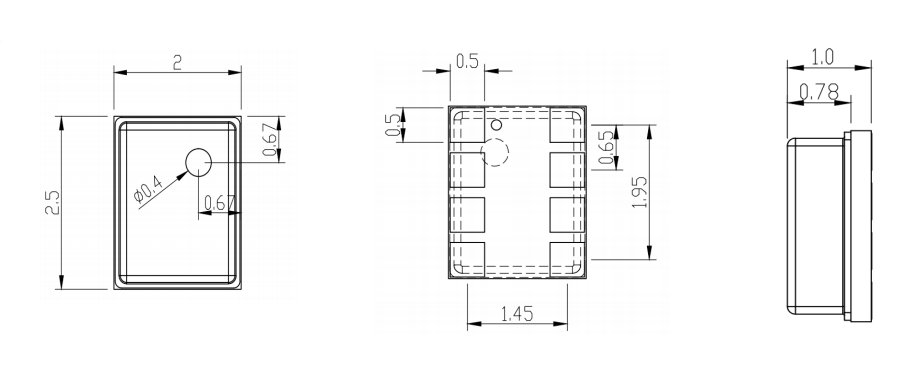Katalog
Modern portable climate loggers rely on precise environmental parameter collection. Barometric pressure serves as a key meteorological element, reflecting weather trends and enabling altitude calculation. MEMS technology advances have significantly improved sensor size, power consumption, and accuracy, providing ideal integration solutions for portable devices.
Barometer Sensor Technology Principle
MEMS Barometric Sensor Mechanism
MEMS barometric sensors use silicon-based micromechanical structures to detect pressure by measuring electrical signal changes from membrane deformation. When atmospheric pressure acts on the sensitive diaphragm, it causes micro-deformation, changing piezoresistive elements or capacitive structures to produce proportional electrical signals with 0.01 hPa resolution.
Piezoresistive vs. Capacitive Technology
Piezoresistive sensors utilize semiconductor piezoresistive effects with mature manufacturing processes and lower costs but higher temperature coefficients. Capacitive sensors detect pressure through capacitance changes, offering better temperature stability and long-term reliability, making them preferred for portable applications despite complex manufacturing.
Digital Interface and Signal Processing
Modern barometric sensors integrate digital signal processing circuits supporting I²C or SPI protocols. Built-in ADCs and digital filters output calibrated pressure data directly, simplifying system design. Premium models include integrated temperature sensors for real-time compensation, enhancing measurement accuracy and system reliability.

Portable climate recorder application requirements
Outdoor Environmental Monitoring Requirements
Portable climate loggers face challenges including severe temperature changes, humidity fluctuations, and mechanical shocks in outdoor environments. Barometric sensors must maintain stable operation from -40°C to 85°C while providing excellent vibration resistance and waterproofing. Sensor packaging must balance gas exchange channels with environmental protection needs.
Real-time Data Acquisition and Storage
Climate loggers require continuous pressure monitoring with sampling rates from 1Hz to 0.1Hz to capture short-term fluctuations and long-term trends. Sensor response characteristics directly impact data quality, with premium MEMS barometers achieving response times under 100ms. Combined with low-power design, devices can record continuously for months.
Multi-parameter Fusion Analysis
Combining barometric data with temperature and humidity enables calculation of dew point, vapor pressure, and air density. Pressure gradient analysis can track device movement and altitude changes. This multi-parameter fusion provides richer environmental information, particularly suitable for mountaineering navigation, meteorological research, and agricultural monitoring applications.
Advantages of sensor integrated design
Miniaturization and Space Efficiency
MEMS barometric sensors have shrunk to 2.5mm×2.5mm×0.95mm packaging, providing excellent space utilization for portable devices. LGA or BGA packages support surface mount technology, enabling integration with other electronic components on compact PCBs. This miniaturization allows smartwatches and fitness trackers to easily integrate complete weather monitoring functions.
Low Power Operation Characteristics
Modern barometric sensors consume only 1-5µA in normal operation and below 0.1µA in standby mode. Through intelligent power management, sensors support on-demand wake-up and intermittent sampling modes, further reducing overall power consumption. This low-power characteristic enables small loggers using coin cell batteries to operate continuously for years.
Digital Integration Convenience
Barometric sensors provide standardized digital interfaces supporting multi-device bus connections and plug-and-play configuration. Built-in calibration coefficients and temperature compensation algorithms reduce software development workload, accelerating time-to-market. Manufacturers typically provide complete drivers and application examples, lowering technical barriers for system integration.
Selection criteria and performance evaluation
Accuracy and Resolution Requirements
Portable climate loggers have varying barometric measurement accuracy requirements by application. General environmental monitoring requires ±1 hPa absolute accuracy, while high-precision altitude measurement needs ±0.06 hPa accuracy levels. Sensor resolution should reach 0.01 hPa or higher to capture minute pressure changes. Selection must consider nonlinearity, hysteresis, and repeatability specifications.
Temperature Stability and Compensation Mechanisms
Barometric sensor temperature coefficients directly affect measurement accuracy, with quality sensors maintaining coefficients within ±0.5 Pa/K. Built-in temperature compensation algorithms maintain accuracy across wide temperature ranges, but periodic calibration ensures long-term stability. For extreme environment applications, enhanced temperature compensation sensor models are recommended.
Mechanical Reliability and Environmental Adaptability
Portable devices frequently face mechanical stresses including drops, vibrations, and temperature shocks. Barometric sensor packaging structures require sufficient mechanical strength, verified through drop and vibration testing. Operating temperature ranges should cover expected application environments, with storage temperatures considering shipping and storage conditions. Water resistance ratings and chemical compatibility are important selection factors.

System optimization and data processing
Multi-sensor Data Fusion
Portable climate loggers typically integrate multiple sensors, fusing barometric data with temperature, humidity, and accelerometer data for more accurate environmental analysis. Through Kalman or particle filtering algorithms, systems reduce individual sensor measurement noise, improving overall data quality. Inter-sensor time synchronization and data alignment are key technical points for effective fusion.
Adaptive Sampling and Power Management
Adaptive sampling strategies based on barometric change trends reduce power consumption while maintaining data quality. Systems automatically increase sampling frequency when detecting rapid pressure changes and decrease frequency during stable periods to conserve power. This intelligent sampling mechanism combined with dynamic power management enables flexible switching between operating modes.
Data Quality Control and Anomaly Detection
Barometric data quality control includes outlier detection, trend analysis, and consistency verification. By setting reasonable data range thresholds and change rate limits, systems identify and flag anomalous data points. Combined with statistical analysis methods, sensor drift and systematic errors can be detected, establishing data quality scoring mechanisms.
Zaključak
Barometric sensors play crucial roles in portable climate logger design, with MEMS technology achieving significant advances in miniaturization, low power consumption, and high accuracy. Through proper sensor selection, optimized integration design, and intelligent data processing algorithms, portable climate loggers provide reliable environmental monitoring capabilities. As IoT and edge computing develop, barometric sensors will create greater value in smart meteorology, precision agriculture, and environmental protection.
Gornji uvod samo zagrebe površinu primjene tehnologije senzora tlaka. Nastavit ćemo istraživati različite vrste senzorskih elemenata koji se koriste u različitim proizvodima, kako rade te njihove prednosti i nedostatke. Ako želite više pojedinosti o tome što se ovdje raspravlja, možete provjeriti povezani sadržaj kasnije u ovom vodiču. Ako ste u stisci s vremenom, također možete kliknuti ovdje za preuzimanje pojedinosti o ovim vodičima Podaci o senzoru zračnog tlaka PDF podaci.
Za više informacija o drugim tehnologijama senzora, molimo Posjetite našu stranicu senzora.
